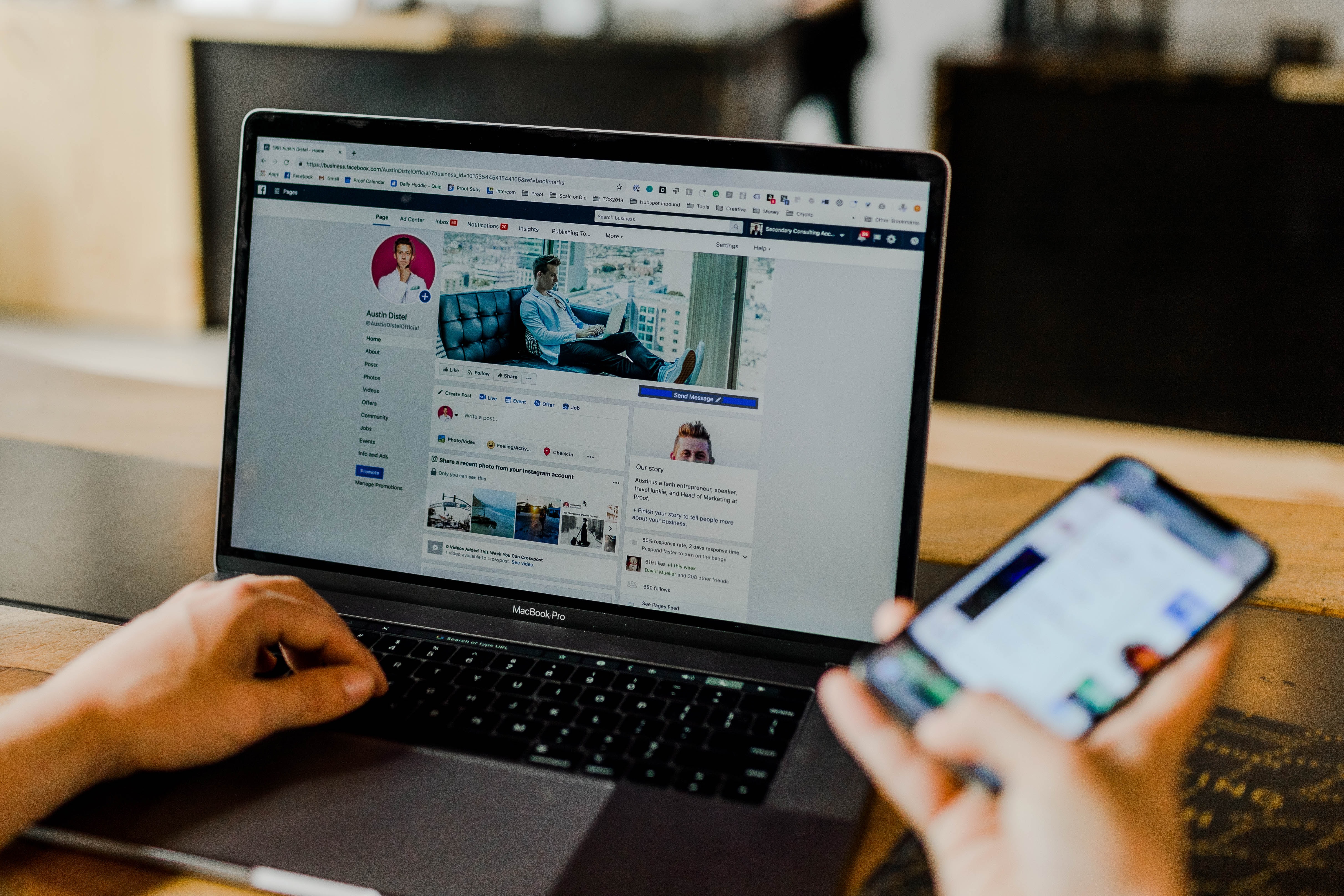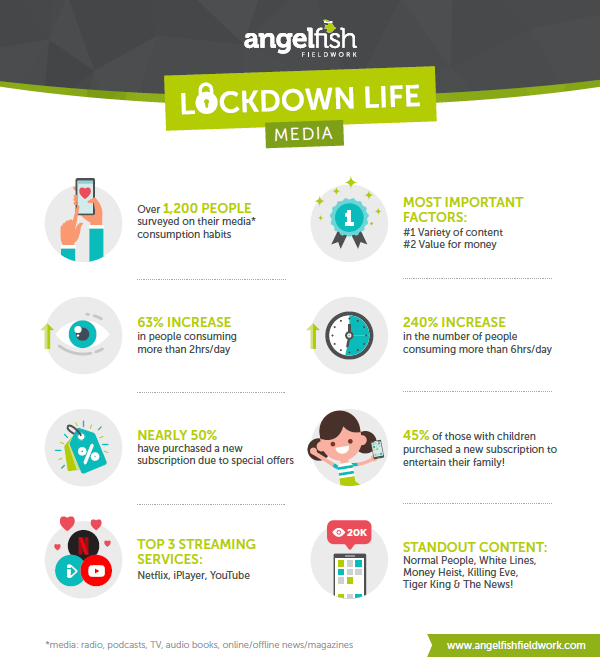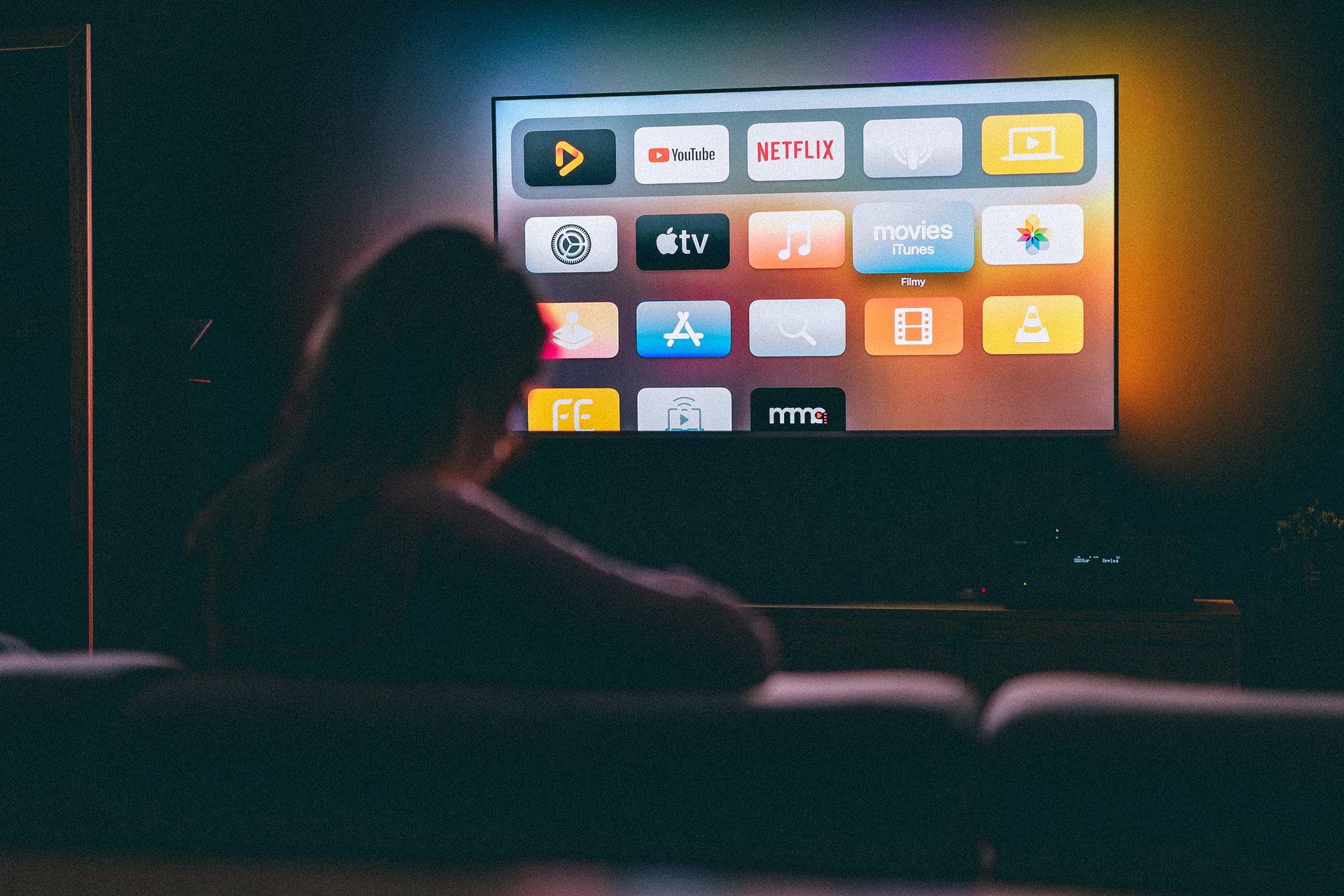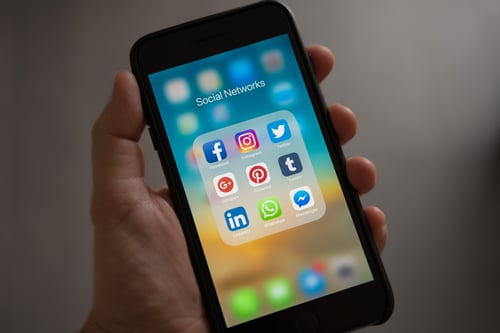
“A window on the world" – how COVID-19 has changed media consumption
We’ve been recruiting participants for media market research projects since our inception here at Angelfish Fieldwork.
In that time, we’ve had the pleasure of working with some of the world’s most renowned media companies, such as the BBC, Channel 4, Sky and Universal Music Group, and have subsequently built up a strong reputation for media market research recruitment across a diverse range of audiences.
As our experience recruiting participants for research in the sector has grown, so has our own interest in all things media, and media consumption.
… and our interest only grew during the coronavirus pandemic! With the UK population confined to their homes for the majority of their time, media became one of the main ways that people kept themselves busy and passed the time.
This was when we conducted our first Lockdown Life: Media research project, from which we uncovered the following (and very intriguing) insights:

As life has gradually returned to (almost) normal, we wanted to dig a little deeper into our findings, exploring how the pandemic has changed media consumption, and whether this change has stuck.
We surveyed 1,000 amazing individuals in our community to gather their views, experiences and opinions on media consumption before, during and after the pandemic.
Read on to find out more about our pandemic media consumption research study...
What we wanted to find out...
In light of the coronavirus pandemic and our own knowledge and expertise in the media market research sector, we wanted to find out:
- whether people consumed new kinds of media, or if they stuck with what they knew
- whether these changes have stuck as we’ve come out of the pandemic
- if there were similar reasons behind people’s answers to 1 and 2
- if 1 and 2 were affected by certain demographics (such as generation)
1. To kick off, here’s a bit of background from other sources:
- WARC discovered that COVID-19 caused digital consumption to rise by over 30%. For example, user activity doubled on TikTok during 2020, and gaming and eSports audiences expanded.
- Forrester predicted heavy TV/video consumption would continue following the pandemic, with offline consumption reducing as online consumption increases.
- Visual Capitalist found significant generational differences in media consumption; for example, Gen Z reported a vast increase in almost all kinds of media consumption, while Boomers’ activity increased and decreased in different areas.
- Similarly, Deloitte found that, compared to older generations, Gen Z prefer to play video games, stream music, and engage on social media, rather than just watch TV or movies like their generational counterparts.
- With work-from-home policies in place, Nielsen found that, with less time spent commuting (resulting in 54% of workers from home getting up later in the morning and 49% staying up later at night), a large number of people spent this time consuming media instead.
- Neilsen also examined the effect of COVID-19 on human psychology, uncovering that people found more comfort in familiar music and television shows during the pandemic, compared to looking for new things (with 87% of respondents listening to the same music and 54% re-watching episodes of old favourite shows).
- Similarly, a recent study on COVID-19's impact on entertainment choices, more than half of respondents said that they found comfort in revisiting old favourite TV shows and music.
- Studies have also found that people used the internet and other forms of media as a means of escapism during the pandemic.
2. … and then wanted to find out if....
1. Media consumption will likely have changed due to the pandemic, mainly as a result of people:
- needing a cure for boredom
- looking for escapism
- seeking comfort/familiarity
2. There will be a mix of those who stuck with the same kinds of media (most likely those looking for comfort and familiarity), and those who tried new things (those who are more easily bored).
3. There will be a change within the methods through which people consume media
4. Demographics, namely generation, will have an impact on the above.
5. In the “new normal,” these changes are likely to remain for the long haul.
3. Then it was over to our fantastic community to fill in any gaps for us!
What we discovered (at a glance):
Has media consumption changed?
- The need to/for:
- alleviate boredom stayed the same
- escapism increased
- feel better increased slightly
- Having more time, working from home, wanting to feel connected and wanting to stay informed about what’s happening in the world were cited as reasons for greater media consumption.
- There was a mix of those who tried new things and those who stuck to the same things – but consumed more of them!
Generational insights:
Gen Z: Social media was consistently the most popular. However, during the pandemic, they ventured into films and video games more.
Millennials: Films were consistently the most popular; however, this decreased along with social media usage.
Gen X: TV was consistently the most popular; however, this this reduced greatly while social media usage increased.
Boomers: TV was consistently the most popular, although this also reduced significantly compared to before the pandemic.
Will these changes stay for the long haul?
We think yes – particularly if working from home remains in place!
So... how many of our first thoughts were correct?
1. Media consumption will likely have changed due to the pandemic, mainly as a result of people:
Needing a cure for boredom
Boredom was the biggest reason for people consuming media both before the pandemic, and since the lockdowns. Interestingly though, this neither increased nor decreased post lockdown lifting!
However, as shown in our word cloud and participants’ quotes below, boredom during the pandemic did seem to cause a significant push towards greater media consumption:
- “I probably consume more due to boredom and stress and less opportunity to go out.”
- “Yes, everyone is bored and at home so more time on their hands to make videos, cook, crafts etc.”
- "It has made us consume it more out of boredom than doing it with intention.”
- “It has absolutely changed the way people consume media. Boredom for older people and the fear of missing out for the young.”
- “Yes. I think we use it more to stay in touch and out if boredom and frustration.”
Looking for escapism
Prior to the pandemic, escapism from the real world was the third most popular reason for consuming media at 14%. This rose to 19% after the pandemic.
Significant quotes from participants about escapism included:
- “Not sure – perhaps we spend more time trying to escape the real world now. That is to try and forget about the problems in the world, especially the pandemic!”
- “Absolutely yes, People use it to keep in touch with friends/ family that they can no longer see. Also use it as an escape from the real world but at the same time to find out what is going on in the world.”
- “I think we have gone into our virtual worlds, I run a Facebook Roxy Music fan group and Instagram site since just before the pandemic, contributing features and content weekly and have 1,100 followers now, people are looking to escape.”

Seeking comfort/familiarity
Using media to feel better was the lowest selected reason for participants’ media consumption before the pandemic at 4%. This increased slightly to 6% following the pandemic, overtaking fear of missing out and because someone had recommended something:
- “More of it and to feel better mentally.”
- “I do because I think we have more choice than ever and feel vulnerable, so seek media either for answers or reassurance or just for a pure distraction from all the noise of the bad news, so we are more demanding and want what we want when we want it.”
One of the standout elements of this was feeling less lonely:
- “Some people have changed their usage, gone off grid or have become more involved in social media. To be free or to feel included.”
- “I definitely spend more time on social media and I read a lot more of the news now. The pandemic has caused a lot of anxiety and there have been so many change of plans. Social media was a way to feel less lonely.”
- “Yes, I think we spend more time at home and at times you feel more lonely so to avoid that.”
Interestingly, however, some participants quoted that the increase in media consumption had made them feel worse, so they either changed their habits or removed them altogether:
- “Yes changed – I try to follow accounts that inspire me and give me confidence rather than make me feel inadequate.”
- “I feel it scares people I use it less too as my mental health has got worse.”
While the factors above increased (or stayed the same) as a result of the pandemic, some actually decreased. For example, we found that:
- fear of missing out decreased by 2%
- because someone recommended something also decreased by 2%
- to learn something decreased by 4%
The only other factor that remained the same was “To get inspired” stayed at 8%.
When asked “Do you think the pandemic has affected the way we consume media? And why do you think this?”, a number of other significant contributors came up, including:
Having more time
- “I think we have more time to consume media and have got used to being attached to it to hear the latest COVID updates.”
- “Definitely yes. People have more free time, social media is easily available, it is used by more and more people of all generations to write posts, connect with others and express views and opinions.”
- “The pandemic gave us the most free time we've ever had, with this free time comes boredom but also a chance to follow interests that we've never had the chance to.”
Those who had less time on their hands also indicated that things were the same as they had been before, further demonstrating time as a significant factor:
- “I watch more news than before the pandemic but otherwise I haven't noticed much change. I have worked throughout the pandemic going to the office every day, so my life hasn't changed much.”
Working from home
Similarly to having more time, people indicated that working from home had an influence on their increased media consumption:
- “I do as I work from home now, I watch TV whilst working which I could never do in the office.”
- “Yes, we use it more now because lots of people work from home, they save plenty of time travelling to work and back.”
- “Yes, more time such as listen to music or the radio while working from home, watch lunchtime news some days etc.”
Connecting with others
- “I think people use it more to stay in contact with loved knew that they are not seeing as often as they did before the pandemic.”
- “I think we are more reliant on media than before because there has been less person-to-person contact.”
- “Yes, we tend to become more virtual. We are connecting with more people virtually and we are using it more.”
- “Yes, that's the only connection to the outside world.”
Keeping informed on what is happening in the world
“News” appears in our word cloud – and it’s unsurprising when you see the responses about it!
- “I think there is a stronger relationship to news outlets and social media. People better understand the need to know what's going on in the world as rule changes directly affect them.”
- “People have found their tribe online on a specific platform where they share similar views and can keep abreast of the latest goings on with the current political situation. This probably means they have moved from a specific platform to one in particular which serves their needs, for instance for escapism or for news.”
… And many responses revealed a mix of all the above factors, some intertwining with each other!
- “It is available for everyone and has been used more with people exploring creativity. Therefore, we are watching, consuming and using it more to catch up, keep up with things, escape, manage boredom or keep in touch with others and the world.”
- “I think people use social media more in general since pandemic. My opinions to why is boredom. Lack of imagination, more spare time, but also to feel a sense of connection to others and also to prevent isolation.”
The pandemic certainly has had an impact on people’s media consumption; both in terms of them using it more frequently, and in their overall choices.
2. There will be a mix of those who stuck with the same kinds of media (most likely those looking for comfort and familiarity), and those who tried new things (those who are more easily bored).
Those who said they became bored easily were more likely to watch films and use social media before and after the pandemic compared to those who said they didn’t get easily bored, and there was a change in the types of media they consumed; for example, watching TV decreased for this group after the pandemic by 7%, whilst film and books increased by 2%.
Interestingly, TV consumption reduced by 5% and film consumption increased by 3% across the board, whether participants described themselves easily bored or not, or liked trying new things or not – in fact, the score for watching films doubled for those who didn’t like trying new things, which goes to show how much the pandemic has affected our media consumption in this area!
Nostalgic people’s (those more inclined to seek familiarity) media consumption methods stayed the same; however, same as other groups, their preference for film increased – in this case by 3%, while TV decreased by 6%.
As an interesting side note, “fear of missing out "decreased in those who described themselves as having FOMO from 14% to 10% – escapism and boredom seemed to increase as drivers here!
From the responses we received, there was indeed a mix of people sticking to the same things – however, it appeared that some were consuming more of those things:
- “I'm sure it has changed things for many people, as they are home more. I am about the same really.”
- “I think media is used in the same way as before, but more social media use due to lockdown and not seeing friends.”
- “No, I don't think there will be notable change in how media is consumed. People using it same reasons now as they did historically.”
and those who tried something new:
- “Certainly, it’s extended the range of media we consume, but whether people consume it differently, I don't know. I am thinking about trying a VR headset, something I thought I would never be interested in. But hey, you only live once 😊."
- “I think we are more reliant on it and will explore much more than we used to rather than just sticking to the same channels.”
3. There will be a change with the methods through which people consume media
We asked about the kinds of streaming services people used before the pandemic, during lockdowns and now, as well as the types of social media they used in those same periods.
Streaming services
Use of Amazon Prime Video, Apply TV+, Disney+, Netflix, BritBox, DAZN and Freeview increased across all participants; in fact, the only ones that decreased were Hulu and Hayu. This confirms that streaming services saw a boom in popularity as a result of the pandemic.
At a glance, Hayu has a one-star rating on TrustPilot, and Hayu 1.5, whilst Netflix, Disney+ and the other services named have much better reviews across the board, which may explain this tip in the balance. This goes to show the importance of the user experience!

Social media
“Keeping in touch with friends” remained the most popular reason for using social media both before the pandemic and now; however, this did reduce from 64% to 51%.
“Sharing updates” remained the same at 6%, whilst “entertainment” increased from 16% to 22%.
This was all well-reflected in people’s acquisition of new social media accounts; YouTube, perhaps the world’s greatest entertainment social media site (and the world’s most popular search engine) had the biggest jump in new account creations since the start of the pandemic, whilst social media sites used for connecting with others, such as Facebook and Twitter, had significantly smaller increases.
TikTok also enabled more people to become creators as well as consumers:
- “TikTok has changed the way I use social media. I only used to spend a few hours on social media (Snapchat and Instagram) now TikTok combines friends and entertainment and I use it a lot more.”
- “I consume more online media and streaming services than before, and TikTok has become a bigger part of my life than I'd prefer! People needed something to do, and with more time at home, media has become a big part of life.”
There was a jump of 14% to 22% of people using social media to catch up on the news vs. traditional TV channels.
- “I believe that the pandemic has caused people to consume media in more different ways – watching shows, downloading etc across multiple devices.”
- “I think it largely became our window on the world, the place to keep up with our friends, check they were ok and to vent frustration.”
Social media as a tool for all forms of media consumption:
- “We binge watch programs now, social media is our main form of contact, and it serves all purposes now entertainment, communication and social interaction.”
- “We tend to use media more as a tool for entertainment (the government) sharing (hobbies/sport) and generally as a means of keeping in touch worldwide.”
4. Demographics, in particular generation, will have an impact:
Gen Z: Social media was the highest form of media consumed both before the pandemic and currently, however, this did reduce significantly from 62.5% to 43.8%. There was, by contrast, a big jump in film consumption (from 3.1% to 15.6%), and video game consumption almost doubled from 3.1% to 6.3%.
Millennials: Film was the highest form of media consumed both before and after the pandemic. Social media usage (second most used overall) decreased marginally from 26.7% to 22.2%. This marginal difference in time was otherwise spent on podcasts, books and video games.
Gen X: TV was the highest form of media consumed both before and after the pandemic, though this did decrease slightly from 49.6% to 41%. Conversely, their second-most consumed media type both before and after the pandemic, social media, increased from 15.3% to 20.7%.
Boomer: TV was the highest form of media consumed both before and after the pandemic with the second most-consumed form of media, radio, remaining the same. Newspaper/magazine consumption reduced by more than half (from 4.9% to 2.3%).
Overall, while every generation’s favourite form of media stayed the same, the pandemic saw them spending less time on those things and looking into other forms of media – seems like the pandemic was a real instigator for change in media consumption, regardless of age!
5. In the “new normal,” these changes are likely to remain for the long haul.
There were certainly a lot of responses that indicate that the pandemic has made some of people’s new media consumption habits permanent:
- “I think we stream far more content now. We learned that normal TV just isn't enough, we need to be able to watch all episodes at the same time (binge watch). I feel we have come to expect that now, and it directly influences what we watch.”
- “Yes. People spent more time than before the pandemic and found new Series, boxsets and used the spare time to watch more TV. People are also keen for updates and news on the pandemic.”
- “I think people will use media more after the pandemic as they probably used it a lot during the pandemic.”
Conversely, some said that these changes might not stick around for the long haul, and that there are other factors involved:
- I watched lots of films and done lots of TikToks during the pandemic and even though I still watch TikToks now I don't make them as much. I think I don’t use it so much now or watch as many films/tv now is because I can go to work, I can see my friends I don't have the same need for escapism as I had during the pandemic.”
- “I watch same amount of news etc but many people have gradually in life become addicted to it anyway so I don't think the pandemic can be blamed.”
Quite the mix!
What does this mean for the media industry? (Thoughts for the future)
Media consumption has certainly changed following the pandemic:
- While media consumption has indeed increased, people are now much more selective about their choices, and definitely focused on the user experience.
- People are more willing to try new things now than they were before the pandemic – and this is reflected across generations!
- People are actively looking for opportunities for entertainment, to connect with others and keep in touch with what’s happening in the world more than ever.
- Fear of missing out (FOMO) is no longer as strong a pull as it used to be.
- People are more scrutinous of their news sources.
- Whether these changes will remain for the long haul remains to be seen – however, based on responses about working from home, if this remains in place, it’s more than likely!
Looking to conduct market research around media consumption?
This is just a snapshot of the incredible responses and insights you could see in your own media market research when you team up with Angelfish Fieldwork for participant recruitment!
In fact, we know just where to find the best participants for your study. So, whatever your media market research goals, you can be assured you’ll be in safe hands with us!
Simply get in touch with us to discuss your project, and we’ll be ready to get started!













